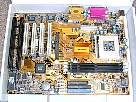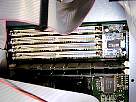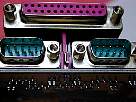Parts of Motherboard


Parts of a motherboard.


Parts of a motherboard.
 This is ... | ... my motherboard. From left to right ... |
 The four white connectors ... | ... are the PCI slots (numbered from 1 to 4 from left to right). Most of the present boards but the graphics ones, have this kind of connection. The PCI4 is normally only used if the second ISA is not occupied (although electrically both can be used). |
 This is the power supply connector, ATX type ... |  ... and so it will be plugged. |
 And here we come to the headache of my friends who are not very much introduced in the world of computers:... | ... the RAM sockets or connectors: the part that is guilty (when short) that computers move as turtles. The three in the photograph at the left are DIMM (black with little white levers at the ends). |
| A PC ends by becoming a snail, if it has not a MINIMUM of 96-128 Megabytes of RAM with Windows 98, or between 128 and 160 Megabytes of RAM with Windows 2000. |  Going on from down left, this is the famous BIOS, that keeps the code program that starts the PC before the ... |
 ... the two black connectors ... | ... at the left are old ISA slots, now becoming obsolete, that can be useful to connect some old boards, i.e. a LAN board that we keep in the "old but useful devices" drawer. |
 This is the AGP slot ... | ... it is only used for graphics boards (where the monitor is plugged). Nowadays, graphics boards are manufactured almost exclusively with this kind of connection |
 This is the CPU socket ... | ... that in this motherboard has to be Intel socket 370 type (PPGA or FCPGA). AMD processors need another kind of motherboard; they are not interchangeable (in this motherboard one cannot even plug Pentium III slot-1) |
 This photograph, that corresponds to other PC 2-3 years old, shows filled... | ... its DIMM slots and four empty slots (white) of SIMM memory. When purchasing memories to increase the size (upgrade), one has to report which kind of slot, base speed of CPU clock (for instance, 66, 100 ó 133 Megahertz), and, if possible, show the motherboard's handbook. |
 ... operating system load, and this is the battery ... | ... that helps to keep the BIOS configuration, clock, ... when the computer is off. Under the battery, in the long black connector, we connect the internal loudspeaker, reset, LED's ... |
 Whithin these three connectors, the one shorter up is for the floppy disk flat cable connector,... | ... the one at the center (black) is for the second flat cable (IDE2) to connect hard disks, CD's or DVD's, and the one down (blue) is for the first cable (IDE1) to connect disks. (each flat cable can handle two devices, one as master and the other as slave). |
 ... the joystick connector (15 pins) ... |  ... over, the parallel port ... |
 and, last, these are the connectors for |
 This motherboard is equipped with internal modem, and this is the place to plug its connector (right). And now, going to the upper part of the motherboard, ... |  ... and looking from the rear, from right to left, here we find the three audio connectors (this motherboard does not need an additional audio board) ... |
| ... connector of 25 pins (pink) for printer connection, and down COM1 (left) and COM2 (right), the serial ports (where one can plug external modems and other devices) |  These are the two USB connectors (all external devices are nowadays equipped with this kind of conection |









